A decade ago, AI was a silent assistant crunching numbers, sorting data, and responding when asked. It was powerful, yes, but passive.
Today, that’s changing dramatically. We’re entering a new era, an era of agentic AI, where machines are no longer just tools waiting for commands. They’re becoming intelligent collaborators, capable of pursuing goals, making decisions, taking initiative, and adapting on the fly. These AI agents don’t simply wait for instructions, they determine the best course of action within the goals and boundaries set by humans, working to enhance human judgment and efficiency.
For business leaders navigating complexity, disruption, and rising customer expectations, this shift isn’t just exciting, it’s essential. The old model of rule-based automation and isolated intelligence is reaching its limits. Enterprises now need AI systems that can understand context, act with autonomy, partner seamlessly with employees, and continuously learn without constant oversight.
That’s where agentic AI enters. Imagine a retail platform where autonomous retail AI agents work alongside planners to continuously optimize supply chains based on real-time demand. Or a manufacturing plant where digital agents support engineers by predicting downtime, triggering maintenance, and reconfiguring workflows to keep operations smooth. Or a distribution ecosystem where fleets self-organize based on traffic, fuel efficiency, and delivery urgency, freeing teams to focus on strategic decisions and customer service.
This is not a distant future; it’s happening now in boardrooms, control towers, and enterprise platforms across industries.
But what exactly is agentic AI, how does it work, and why should it matter to your business today? In this blog, we’ll unpack its core principles, real-world applications, and strategic impact, so you can see how to put it to work to boost efficiency, enhance human-AI collaboration, and unlock adaptability, speed, and intelligence at scale.
What is agentic AI? A strategic definition for business leaders
Agentic AI explained simply
Agentic AI refers to advanced artificial intelligence systems designed to operate with autonomous agency, meaning they can set goals, reason through complex scenarios, make decisions, and take purposeful actions independently. Unlike traditional AI models or simple AI agents that respond to specific commands or execute narrow tasks, agentic AI acts proactively and adapts dynamically to changing environments.
At its core, agentic AI combines multiple capabilities: perception, planning, learning, and execution. These systems not only analyze data but also formulate strategies, prioritize objectives, and collaborate with humans or other AI agents to drive meaningful outcomes. This level of autonomy enables enterprises to scale decision-making, automate complex workflows, and innovate faster in rapidly evolving markets.
For business leaders, understanding agentic AI means recognizing its role as a transformational force moving AI beyond passive tools to becoming an active partners in achieving enterprise goals such as operational efficiency, customer personalization, and agility. By deploying agentic AI, organizations can orchestrate tasks end-to-end, reduce human oversight, and unlock new value streams.
In essence, agentic AI is the next-generation AI system that empowers enterprises to navigate complexity with intelligence and autonomy, shaping the future of business transformation.
Key characteristics of agentic AI
Agentic AI is defined by several distinctive characteristics that enable autonomous, intelligent action within complex business environments. Understanding these key traits helps executives grasp how agentic AI drives enterprise transformation.
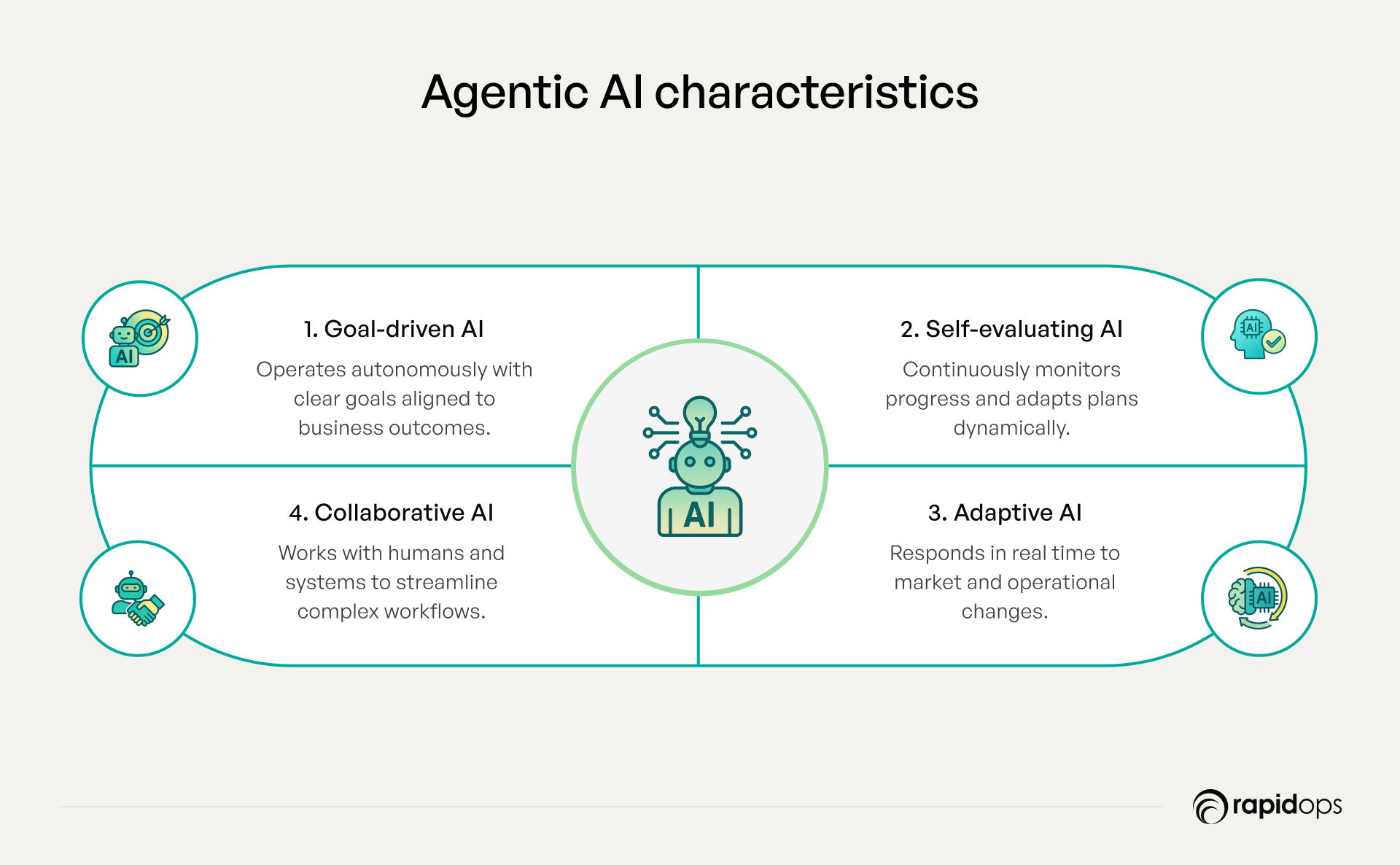
1. Goal-directed behavior
Agentic AI systems operate with clear objectives, autonomously setting and pursuing goals without continuous human input. This purposeful action enables proactive decision-making aligned with strategic business outcomes.
2. Continuous self-evaluation and planning
These systems constantly monitor their progress and assess results, adapting their plans dynamically to address new challenges or changing conditions. This iterative self-reflection ensures resilience and effectiveness in uncertain environments.
3. Dynamic environmental adaptation
Agentic AI can perceive and respond to changes in real time, whether market fluctuations, operational disruptions, or customer behavior shifts, allowing it to recalibrate strategies and actions promptly to maintain optimal performance.
4. Collaboration with other agents or systems
Beyond acting independently, agentic AI collaborates seamlessly with human teams, other AI agents, and enterprise systems. This interconnectedness facilitates orchestration of complex workflows and integrated, scalable solutions across business functions.
By embodying these core characteristics, agentic AI transcends traditional automation to become an autonomous, intelligent partner that drives innovation, agility, and sustained value in today’s fast-evolving enterprises.
Agentic AI vs. generative AI vs. AI agents
As AI technology rapidly evolves, enterprise leaders must clearly understand the distinctions between Agentic AI, Generative AI, and AI Agents to make informed, strategic decisions that drive innovation and efficiency.
Agentic AI represents the most advanced form of artificial intelligence. These systems combine reasoning, planning, memory, and adaptive decision-making to achieve complex goals autonomously. Agentic AI can break down high-level objectives into actionable steps, coordinate across multiple platforms, self-correct based on real-time feedback, and adjust strategies as conditions evolve. This makes Agentic AI ideal for dynamic, end-to-end business processes such as supply chain optimization, autonomous operations, and strategic decision support.
Generative AI, including models like ChatGPT and Claude, focuses on creating new content such as text, images, code, or audio by analyzing vast datasets. It excels at ideation, content creation, summarization, and knowledge synthesis. However, Generative AI operates reactively, requiring human prompts and oversight, and does not independently set goals or sustain ongoing autonomous actions.
AI Agents are specialized autonomous systems designed to perform specific tasks, such as customer service automation, personalized recommendations, or robotic process automation (RPA). These agents perceive their environment, make decisions, and execute tasks within predefined rules but cannot dynamically change their goals or strategies.
By distinguishing these AI types, enterprises can align their AI investments effectively, leveraging Agentic AI for comprehensive, autonomous orchestration, generative AI for creativity and knowledge, and AI Agents for targeted automation. The table below summarizes these differences, helping unlock greater innovation and business agility.
| Characteristic | Agentic AI | Generative AI | AI agents |
| Core capability | Goal-driven autonomy | Content generation | Task execution |
| Control | Self-directed reasoning | Prompt-based | Rule-based |
| Flexibility | High (multi-contextual) | Limited | Medium |
| Integration | Complex (requires orchestration) | Easy | Moderate |
| Best For | Strategic autonomy & coordination | Creative ideation | Automating workflows |
Decision matrix
- For innovative acceleration: Generative AI
- For automating frequent tasks: AI agents
- For dynamic, multi-step processes: Agentic AI
For enterprises, the key is not choosing one over the others, but understanding how and where each can compound value. As systems evolve, these three will increasingly work in tandem, creating, deciding, and acting, across the intelligent enterprise.
Why agentic AI is gaining traction in 2025
Agentic AI is not just another phase in the evolution of enterprise automation; it represents a pivotal shift in how organizations design, deploy, and derive value from AI systems. As the business landscape in 2025 demands greater autonomy, speed, and intelligence, agentic AI is emerging as a cornerstone of enterprise strategy. Here's why.
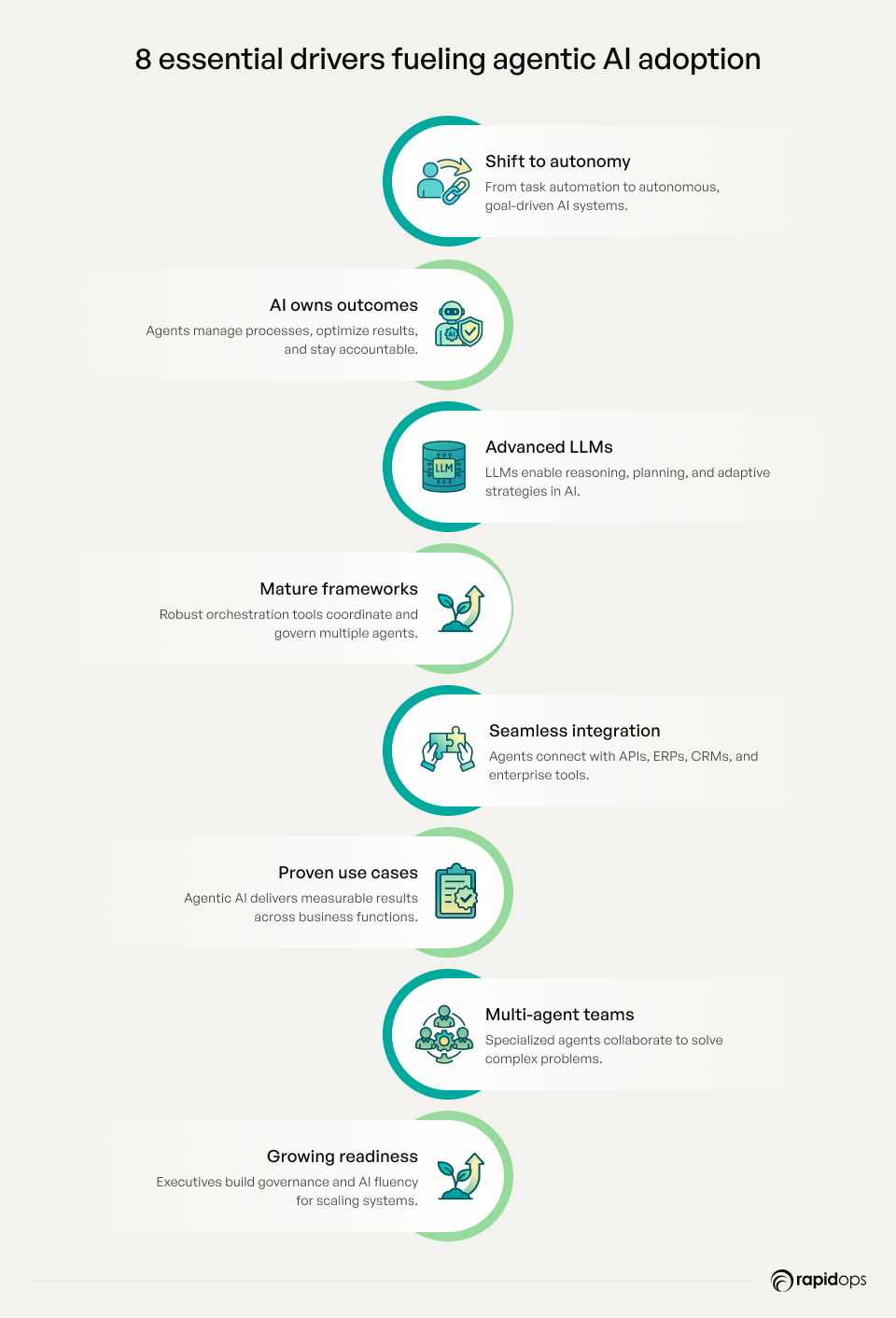
1. Enterprise shift from automation to autonomy
Traditional automation focuses on streamlining predefined tasks. Today's enterprises require systems that can adapt, make contextual decisions, and operate with a level of independence. Agentic AI enables this shift, offloading cognitive load from humans while aligning actions with business goals. The focus is no longer on automating steps but on achieving intelligent outcomes.
2. Demand for AI that owns outcomes, not just tasks
Executives are increasingly looking beyond task automation to AI that can manage entire processes, respond to dynamic inputs, and continuously optimize for better results. Agentic AI introduces accountability into automation agents that can be goal-oriented, results-driven, and operate within defined constraints while owning end-to-end execution.
3. Advances in LLMs with reasoning and planning abilities
Recent breakthroughs in large language models (LLMs) now enable agents to reason through complex problems, plan across multiple steps, and adapt strategies in real time. These LLMs' development capabilities transform agents from reactive tools to proactive collaborators that can support strategic, creative, and operational decision-making at scale.
4. Maturity of agent-orchestration frameworks
With the growing maturity of orchestration tools (like AutoGen, LangGraph, CrewAI, and others), enterprises now have the infrastructure to coordinate multiple agents, govern interactions, and manage hierarchies. These frameworks make it possible to deploy agent-based systems in real-world environments with reliability, modularity, and scalability.
5. Integration with APIs, tools, and enterprise systems
Agentic AI thrives in complex enterprise environments because it can seamlessly interact with APIs, data platforms, CRMs, ERPs, and productivity tools. This integration allows agents to operate across silos, act on live data, and execute tasks within existing systems without disrupting workflows.
6. Proven use cases across business functions
Agentic AI is already delivering value across functions from AI-powered RFP responses in sales to dynamic document generation in legal, and from autonomous IT incident handling to self-directed marketing campaign execution. These outcomes are not theoretical; they're measurable, repeatable, and increasingly becoming part of enterprise best practices.
7. Emergence of multi-agent collaboration models
New models are enabling agents to work in teams, where specialized agents handle specific roles (e.g., researcher, planner, executor) and collaborate to solve complex problems. These multi-agent systems introduce composability, redundancy, and the ability to handle ambiguity traits critical for enterprise-grade AI systems.
8. Growing executive confidence and organizational readiness
C-suite leaders are no longer asking if AI can be trusted; they're designing governance models, enabling oversight, and embedding AI fluency across the organization. As internal readiness grows, organizations are now equipped to scale agentic systems into core operations responsibly.
9. Acceleration of AI-first enterprise strategies
Agentic AI is catalyzing a new wave of AI-first thinking. Rather than retrofitting AI into legacy systems, enterprises are now building products, services, and experiences with AI agent development at the center. This mindset shift is accelerating innovation, time-to-market, and competitive differentiation.
10. Supportive open-source and vendor ecosystems
From LangChain and Semantic Kernel to NVIDIA's NIMs and Microsoft's copilot stack, a rich ecosystem is making it easier to build, deploy, and govern agentic AI systems. These open frameworks and enterprise-grade platforms are lowering entry barriers while offering enterprise-class reliability and extensibility.
How agentic AI works
Agentic AI functions through an orchestrated, multi-stage process that mirrors human cognitive behavior but at enterprise scale and speed. Here's how the core loop works:
1. Perceive: Ingesting and contextualizing data
Agentic systems begin by perceiving their environment, ingesting structured and unstructured data from diverse sources such as enterprise systems, APIs, sensors, user inputs, and digital interfaces. This step involves real-time recognition of relevant signals, patterns, or anomalies through capabilities like natural language understanding (NLU), computer vision, or time-series analysis. The goal is to extract situational awareness to inform downstream reasoning.
2. Reason: Planning with orchestration logic
The central intelligence, typically powered by a large language model (LLM) or foundation model, interprets goals, constraints, and available context. It reasons across tasks using techniques like Retrieval-Augmented Generation (RAG), chaining of thought, and memory-based inference to develop action plans. It may also coordinate specialized sub-agents (e.g., for financial calculations, image generation, or decision trees) to refine or verify outputs. This is where goals become strategies.
3. Act: Executing through autonomous operations
Once a plan is formed, agentic AI takes action autonomously. It integrates with business systems, tools, and external APIs to carry out tasks such as sending customer communications, updating inventory records, analyzing campaign performance, or triggering supply chain workflows. Guardrails ensure every action aligns with enterprise policies. For example, a retail agent might autonomously reorder fast-moving SKUs when stock falls below threshold, while escalating anomalies like sudden demand spikes to a human merchandiser.
4. Learn: Closing the loop with adaptive feedback
Unlike static automation, agentic AI systems are self-improving. They capture feedback from outcomes, both successful and failed, feeding this data back into the models and reasoning chains. This adaptive learning loop sharpens decision-making, reduces errors, and unlocks compounding value over time. This continuous refinement is what allows agentic AI to scale value across evolving enterprise environments.
What can agentic AI do
Agentic AI introduces a new paradigm in enterprise AI automation, moving beyond reactive systems to intelligent, autonomous entities capable of driving strategic outcomes. Unlike rule-based or task-specific AI systems that operate within predefined boundaries, agentic AI functions with purpose, context-awareness, and adaptive intelligence. It acts, not just reacts.
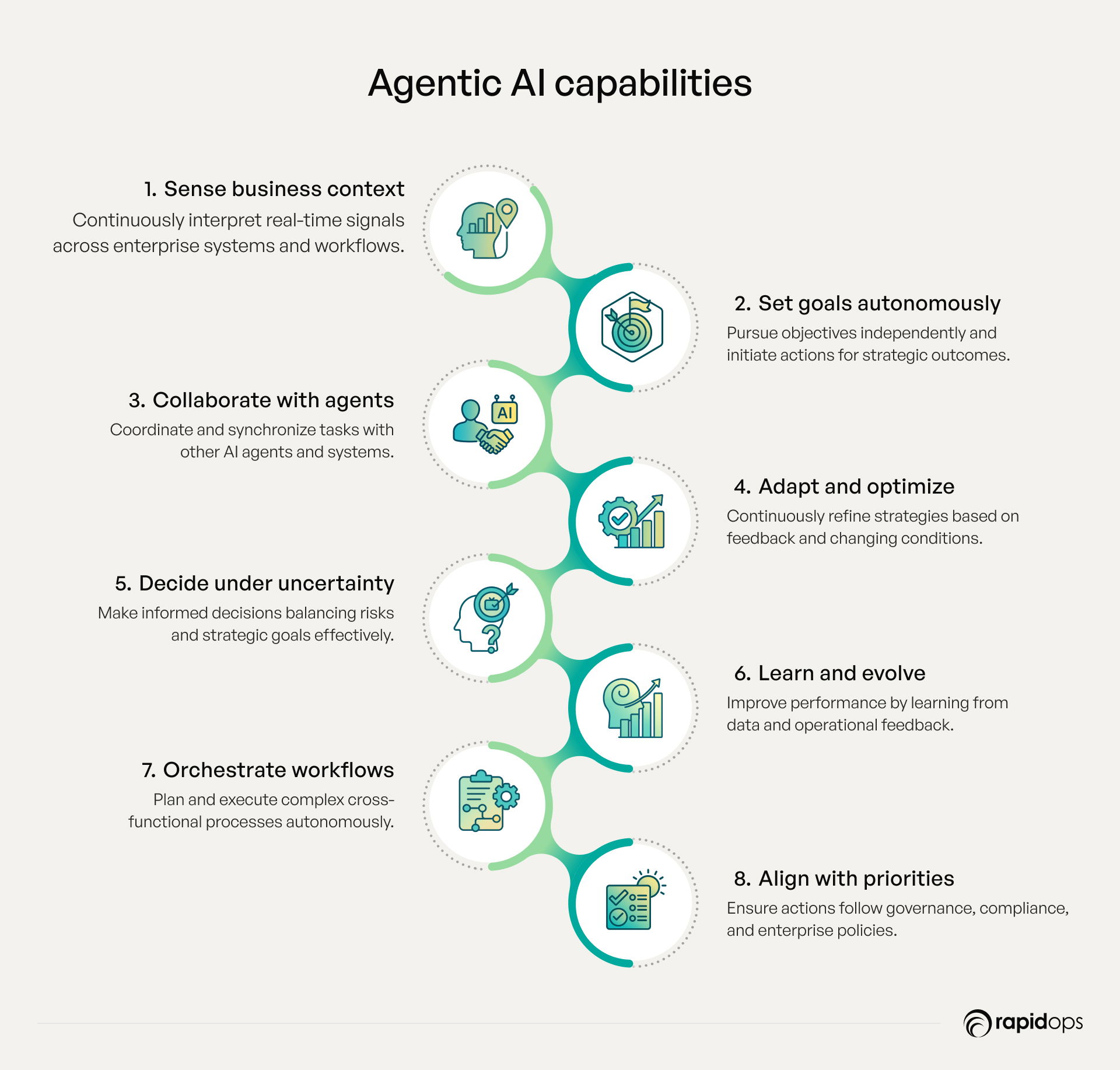
1. Sense and interpret business context in real time
Agentic AI continuously monitors structured and unstructured signals across enterprise systems, applications, and workflows. It synthesizes this information to construct a dynamic understanding of the business environment. This real-time situational awareness allows it to operate with precision, even in complex, distributed environments.
2. Set goals and act with autonomy
At its core, agentic AI is designed to pursue objectives independently. It doesn’t wait for prompts, it evaluates available data, identifies high-impact opportunities, and initiates actions to meet business-defined goals. This shifts automation from task execution to strategic orchestration.
3. Coordinate and collaborate with other agents
Operating as part of a larger multi-agent ecosystem, agentic AI can negotiate, delegate, and synchronize with other agents or systems. This collective intelligence enables distributed decision-making and parallel task execution, significantly improving speed, scalability, and outcome alignment.
4. Adapt to change and optimize continuously
In dynamic environments, agentic AI demonstrates resilience. It continuously evaluates the results of its actions, adjusts its strategies, and refines its approach based on feedback loops and evolving business conditions. This adaptive behavior ensures sustained performance even under shifting priorities or external disruptions.
5. Make decisions under uncertainty
Agentic AI uses probabilistic reasoning and scenario modeling to make informed decisions, even with incomplete or ambiguous data. It balances short-term actions with long-term objectives, ensuring that decisions align with strategic business outcomes, risk thresholds, and compliance frameworks.
6. Learn from experience and evolve over time
Beyond executing tasks, agentic AI builds institutional knowledge. It learns from historical data, operational feedback, and observed patterns to continuously refine its decision models and improve future performance. This learning capability enables compounding gains in efficiency and effectiveness.
7. Orchestrate complex workflows end-to-end
Agentic AI can autonomously plan, manage, and execute cross-functional workflows that span systems, departments, and channels. By linking discrete tasks into cohesive sequences, it transforms fragmented operations into intelligent, outcome-driven processes.
8. Ensure alignment with enterprise priorities and constraints
Unlike generic AI systems, agentic AI aligns its goals and actions with enterprise governance, policies, and performance objectives. It can reason within ethical, regulatory, and operational boundaries, ensuring trust, transparency, and compliance at scale.
Agentic AI places humans where they matter most, at the center of strategic decision-making. It offloads complexity, scales intelligence, and frees up time and focus for higher-value judgment and innovation.
What are the advantages of agentic AI for today's enterprises
Agentic AI is revolutionizing enterprise operations by enabling autonomous decision-making that drives up to a 30% reduction in operational costs and accelerates innovation cycles by 40% (McKinsey, 2024). By processing complex data streams in real time, organizations reduce human error by 25% and respond to market changes three times faster (Gartner, 2023). These capabilities empower businesses to navigate uncertainty with agility, unlocking sustained competitive advantage in today’s dynamic markets.
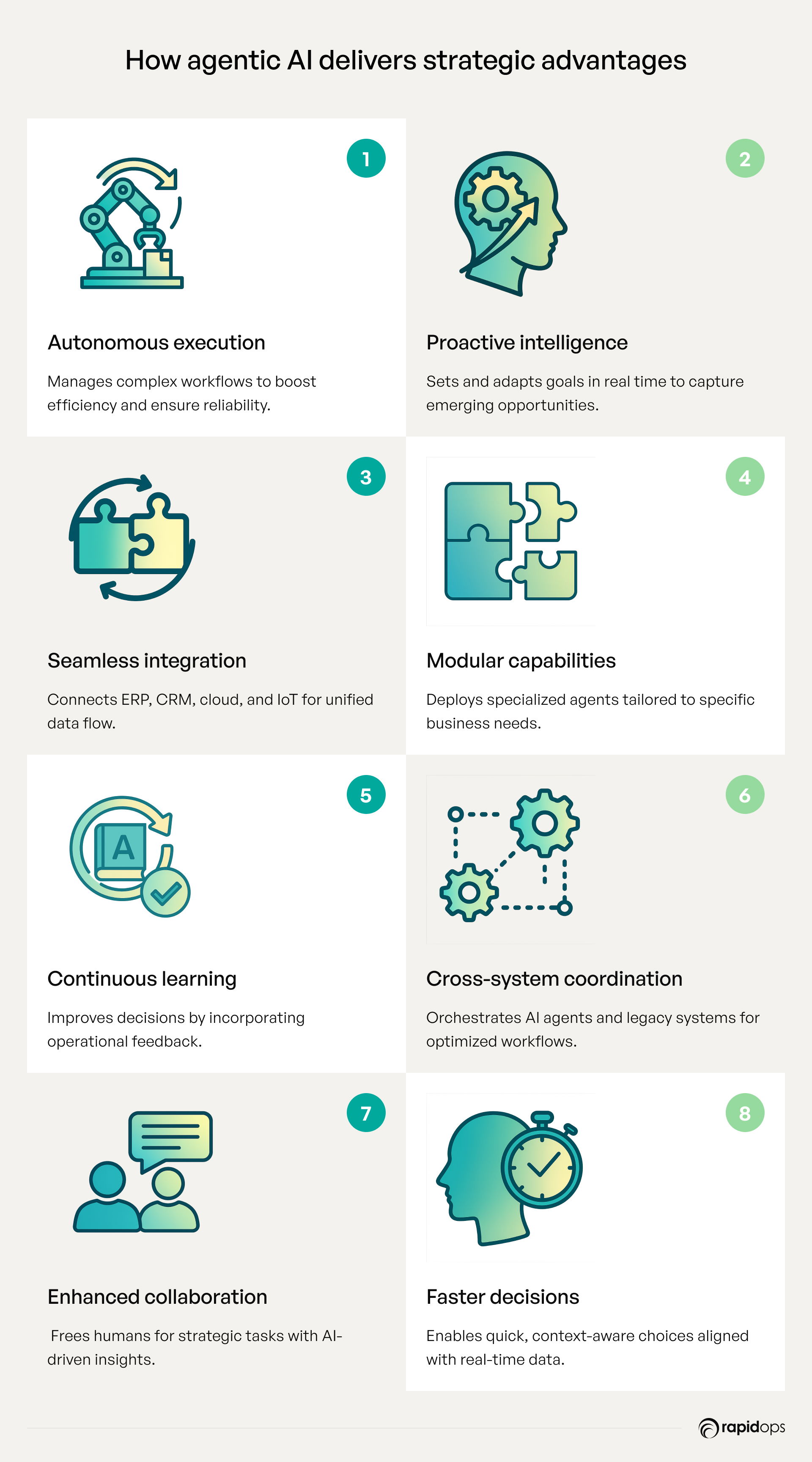
1. Autonomous execution of complex tasks
Agentic AI autonomously manages multi-step workflows, primarily handling low- to medium-complexity tasks across business functions. By automating routine processes, it enhances employee efficiency and fosters seamless human-machine collaboration—accelerating operations, improving accuracy, ensuring compliance, and enabling scalable, reliable business performance.
2. Proactive, goal-driven intelligence
These systems transcend reactive models by setting, pursuing, and adapting to strategic objectives in real time. Agentic AI continuously assesses evolving business conditions, shifting priorities, and potential risks, empowering enterprises to respond proactively and seize emergent opportunities.
3. Seamless integration across enterprise tools
Agentic AI’s design inherently supports deep integration with heterogeneous IT environments, including ERP, CRM, cloud platforms, and IoT ecosystems, enabling real-time data synchronization and end-to-end process orchestration. This connectivity breaks down traditional silos and fosters a unified digital fabric for holistic business insight.
4. Specialized and modular capabilities
By employing a modular architecture, agentic AI enables targeted deployment of specialized agents tailored to specific business domains such as supply chain, customer engagement, or compliance. This flexibility accelerates innovation adoption and facilitates incremental transformation aligned with enterprise priorities.
5. Continuous learning through feedback loops
Agentic AI continuously refines its knowledge and decision-making models by ingesting operational feedback, outcomes, and contextual data. This closed-loop learning drives ongoing optimization, resilience against market volatility, and alignment with shifting regulatory landscapes.
6. Natural language-first interactions
Advanced natural language processing capabilities enable intuitive, human-like interactions with systems and stakeholders, simplifying complexity and increasing accessibility. This fosters broader user adoption, reduces training overhead, and accelerates collaborative decision-making.
7. Intelligent cross-system coordination
By coordinating different types of AI agents at different times and legacy systems, agentic AI dynamically optimizes resource allocation and workflow sequencing. This orchestration capability enhances operational agility, ensuring synchronized execution of interdependent tasks across departments and external partners.
8. Enhanced human-AI collaboration
Rather than replacing human expertise, agentic AI amplifies it—automating routine work to free leaders and specialists for strategic, high-impact decisions. The system provides context-rich insights and recommendations, supporting informed judgment and fostering a culture of innovation.
9. Composable, scalable architectures
Designed with composability at its core, agentic AI supports rapid scaling and customization without disruption. Enterprises benefit from plug-and-play extensibility, enabling seamless integration with evolving technology stacks and business models.
10. Faster, context-aware decision-making
By leveraging real-time data streams and sophisticated contextual understanding, agentic AI enables swift, data-driven decisions that reflect current operational realities and market dynamics. This speed and relevance are critical for competitive advantage and risk mitigation.
11. Reduced operational friction
Agentic AI eliminates manual bottlenecks and process inefficiencies by automating coordination and execution across disparate systems. This reduction in friction results in improved throughput, lower error rates, and enhanced customer and employee experiences.
6 real-world use cases of agentic AI in the enterprise
1. Autonomous supply chain orchestration
In today’s volatile market conditions, manufacturing and distribution enterprises face constant disruptions, whether from supplier variability, shifting demand, or transportation bottlenecks. Traditional supply chains, often optimized for efficiency over agility, struggle to sense and respond in real time.
Agentic AI transforms this reality by embedding autonomous agents across the supply chain to monitor constraints, anticipate changes, and dynamically reconfigure workflows without human intervention. These agents evaluate trade-offs between cost, delivery speed, and capacity in real time, orchestrating just-in-time procurement, production, and fulfillment decisions. As a result, enterprises see measurable gains: faster cycle times, lower inventory costs, and significantly improved service levels, often achieving up to 30% reduction in delays and stockouts.
2. Adaptive dynamic pricing and revenue optimization
Retailers navigating today’s digital and omnichannel environment often face missed revenue opportunities due to rigid, rule-based pricing models that can’t keep pace with consumer expectations or market shifts. Agentic AI introduces autonomous pricing agents that continuously analyze a wide range of signals, consumer demand patterns, competitor activity, inventory positions, promotions, and even macroeconomic indicators, to recommend or implement optimal prices at speed and scale.
These agents adapt dynamically across categories, geographies, and customer segments, adjusting strategies in real time to maximize margins without compromising conversion. Enterprises leveraging this approach have seen significant business impact, including increased sell-through rates, improved gross margins, and 15–20% revenue lift in price-sensitive categories.
3. Proactive, goal-oriented customer support
Customer expectations have shifted from reactive issue resolution to proactive, seamless support across channels. However, most traditional support models are still anchored in ticket queues, scripted responses, and siloed knowledge.
Agentic AI changes this paradigm by introducing autonomous agents that don’t just respond, they anticipate. By continuously monitoring customer behavior, usage patterns, and sentiment across touchpoints, these agents identify friction points before they escalate and take action, whether that means issuing proactive notifications, resolving queries autonomously, or escalating complex issues with context to the right team.
Enterprises deploying these intelligent support agents report measurable gains in CSAT and NPS, faster resolution times (often 25–40% faster), and reduced call volumes, all while deepening customer trust and loyalty.
4. Intelligent field service dispatch and repair
Manufacturers often face unplanned equipment downtime, leading to operational delays, missed SLAs, and rising maintenance costs. Manual dispatch processes and static scheduling tools struggle to optimize for technician availability, skill sets, parts inventory, and job urgency simultaneously.
Agentic AI introduces service agents that autonomously orchestrate the entire repair lifecycle from real-time fault detection to predictive triage, technician dispatch, and resolution confirmation. These agents continuously ingest IoT signals, equipment history, and technician data to make context-aware decisions and adjust on the fly as field conditions change. The result is a smarter, faster, and more responsive service network with enterprises reporting 20–30% reductions in downtime, better SLA adherence, and higher first-time fix rates.
5. Sales agents for lead engagement and pipeline growth
Retail and distribution enterprises frequently face leakage in their sales pipelines, leads go cold due to delayed responses, misaligned follow-ups, or a lack of personalization at scale. Traditional CRM workflows, dependent on manual input and rule-based triggers, are not built for dynamic engagement.
Agentic AI enables autonomous sales agents that monitor every lead interaction, qualify in real time, and drive goal-based follow-ups personalized to buyer context and behavior. These agents learn from ongoing outcomes, refine messaging, and adapt cadence based on real-world feedback, much like a top-performing sales rep operating at digital scale. The impact is clear: accelerated pipeline velocity, increased lead-to-opportunity conversion, and higher win rates, particularly in segments with long or complex sales cycles.
6. Real-time risk detection and mitigation agents
In industries where operational continuity and regulatory compliance are critical, risks often surface too late, whether from supply chain fraud, safety violations, or unexpected shifts in operational thresholds. Static dashboards and periodic audits are no longer sufficient.
Agentic AI embeds intelligent agents throughout enterprise systems to continuously scan for anomalies, emerging threats, and risk-prone patterns across supply chain, operations, and compliance workflows. These agents don’t just alert, they act. They isolate impacted processes, reroute logistics, or trigger preventative workflows automatically. This proactive approach has enabled enterprises to reduce incident response times by 40% or more, avoid regulatory penalties, and strengthen enterprise resilience amid rising volatility.
What should leaders consider before implementing agentic AI
Deploying agentic AI isn't just a technological upgrade, it's a strategic transformation. Leaders must approach it with precision, foresight, and a deep understanding of enterprise readiness. Below are seven critical considerations that should guide any organization preparing to implement agentic AI systems.
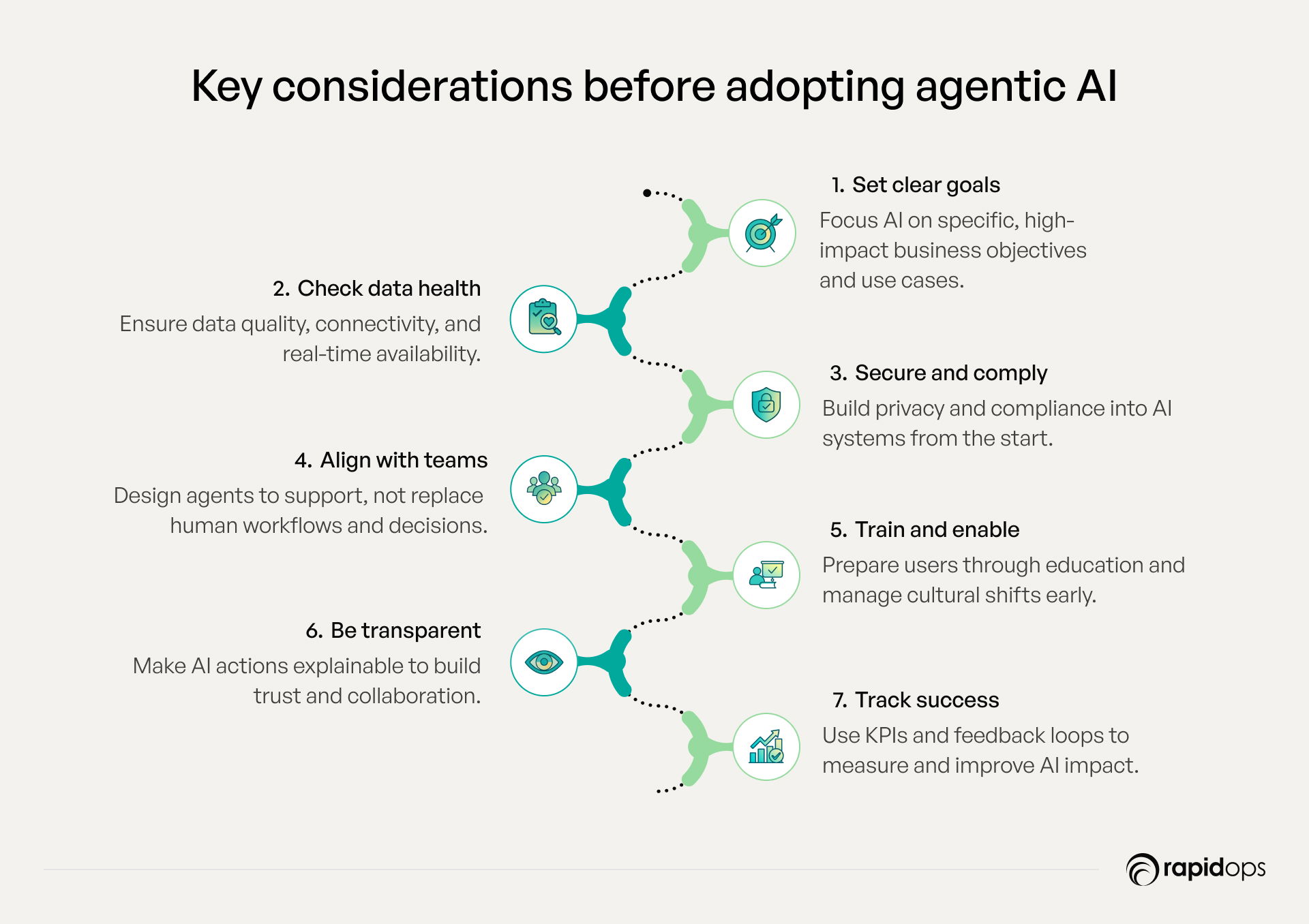
1. Define clear business objectives and use case scope
Before exploring agentic AI, leaders must anchor the initiative to a clear business need. Is the goal to improve customer responsiveness, optimize supply chain operations, or reduce cycle times? Vague AI experimentation leads to cost without impact. Start with one or two high-value domains where autonomy, decision-making, and adaptability can drive tangible results. This clarity will shape everything from agent design to ROI metrics.
2. Assess data readiness, quality, and accessibility
Agentic AI systems depend on real-time, contextual data and not just in silos. Leaders must evaluate whether their current data infrastructure can support the continuous feedback loops that agentic systems rely on. Are data pipelines clean, current, and connected? Are APIs in place to enable cross-functional intelligence? Without the right data foundation, agents can't learn, adapt, or act effectively.
3. Ensure robust security, privacy, and compliance measures
Autonomous agents don't just analyze, they act. That means new risks around data exposure, access controls, and regulatory compliance. Leaders must ensure strong identity management, guardrails for agent behavior, and continuous auditing of decisions. Especially in regulated sectors like healthcare, manufacturing, and retail, compliance frameworks (GDPR, HIPAA, etc.) should be embedded into the agent's logic from day one.
4. Align agent capabilities with human workflows
Agentic AI isn’t about replacing people, it’s about augmenting them. Leaders need to understand where agents can relieve cognitive load, automate repetitive decisions, or surface better recommendations. This requires mapping how agents will collaborate with teams across functions. Consider where agents can offer 24/7 coverage, handle exceptions, or act as first responders while still deferring high-impact decisions to humans.
5. Invest in user training and change management
The success of agentic AI doesn’t hinge on technology; it hinges on adoption. Teams need to trust, understand, and be empowered by these systems. Leaders should invest early in change enablement: train users to work with agents, communicate how decision-making will evolve, and address cultural resistance. An empowered workforce becomes a multiplier for what agents can achieve.
6. Prioritize transparency and explainability in agent actions
Black-box automation erodes trust. When agents take autonomous actions, whether repricing a product, rerouting a shipment, or rejecting a claim, business users need to know why. Leaders should prioritize systems that offer visibility into reasoning paths, trigger conditions, and outcomes. Transparent AI builds confidence, drives smarter collaboration, and helps stakeholders make informed decisions about when and where to intervene.
7. Measure success with outcome-based KPIs and feedback loops
What does success look like for agentic AI? Not just accuracy but business outcomes. Leaders should define KPIs tied to speed, efficiency, cost savings, or customer satisfaction. Just as importantly, they must establish feedback loops to fine-tune agent behavior continuously. This shift from project ROI to ongoing value realization is what turns agentic AI from pilot to production.
What are the emerging trends shaping the future of agentic AI?
Agentic AI is rapidly evolving from task-specific assistants to intelligent, adaptive systems capable of complex decision-making. As businesses look to scale and operationalize these advanced systems, several emerging trends are defining the next phase of Agentic AI development. Here’s a look at the future-forward shifts reshaping the Agentic AI landscape
1. Autonomous goal formulation and dynamic task decomposition
Future agentic systems will move beyond predefined prompts and instructions. Instead, they’ll independently formulate objectives based on context, strategic intent, or observed needs then deconstruct those goals into executable subtasks. This unlocks higher-order autonomy, where agents don’t just act they initiate, plan, and adapt, minimizing human intervention across workflows.
2. Persistent memory across agentic workflows and environments
Next-generation agents will maintain contextual awareness over time. Through persistent memory, agents can recall previous interactions, decisions, and evolving business states creating seamless continuity across sessions, tools, and tasks. This enables more intelligent orchestration, nuanced personalization, and long-term learning at scale.
3. Enterprise-scale orchestration of multi-agent systems
As agentic AI matures, enterprises will deploy networks of interoperating agents each specialized for distinct domains (e.g., sales, logistics, R&D). These agents will collaborate, delegate, and escalate tasks to one another, functioning like digital departments. Centralized orchestration frameworks will ensure security, governance, and optimization across this distributed intelligence.
4. Agent-led simulations for strategic foresight and decision modeling
Agentic systems will become core tools in enterprise decision-making. By running simulations of complex scenarios market shifts, operational changes, competitive actions agents can help leaders stress-test decisions, explore "what-if" pathways, and identify blind spots. These simulations will drive more confident, data-informed strategy.
5. Lifelong learning agents with adaptive knowledge evolution
Tomorrow’s agents will continuously evolve their knowledge base in real time. Rather than static models requiring periodic retraining, lifelong learning agents will adapt based on new data, changing environments, and user feedback. This ensures they remain relevant, resilient, and responsive in dynamic enterprise settings.
Exploration to action: Your next chapter with agentic AI
You’ve explored what agentic AI means, how it works, and why it’s becoming a cornerstone of enterprise innovation. More importantly, you’ve started to consider what this shift means for your business, your customers, and your competitive edge.
Agentic AI isn’t just another wave of automation, it’s a fundamental transformation in how decisions are made, how work is executed, and how intelligence scales across your organization.
At Rapidops, we design, deploy, and scale tailored Agentic AI platforms that help forward-thinking enterprises move beyond pilot projects to achieve real-world impact. Our solutions solve complex challenges, deliver measurable results, and evolve alongside your business. Built on deep execution experience and customized for each unique context, our platforms empower you to unlock lasting value.
Connect with an expert who’s been there
If you’re ready to unlock the transformative power of agentic AI, schedule a free consultation with one of our experts. Our expert will help identify opportunities, align AI strategies with your business goals, and develop a clear, actionable plan to deliver lasting impact.
Frequently Asked Questions
What does “agentic autonomy” mean?
Agentic autonomy refers to the capability of AI systems to independently perceive, decide, and act within complex environments without constant human oversight. Unlike traditional AI that follows fixed rules or simple automation, agentic AI dynamically evaluates changing contexts, sets goals, and orchestrates actions to achieve strategic outcomes. This autonomy enables enterprises to deploy intelligent systems that proactively manage workflows, adapt to new data, and optimize results continuously.
How does agentic AI learn from outcomes rather than just data?
Agentic AI transcends conventional data-driven models by incorporating feedback loops where it assesses the real-world impact of its decisions and actions. This outcome-based learning allows the system to refine its strategies dynamically, not just by analyzing input data patterns but by understanding what works best in practice. Such continuous, contextual learning enhances accuracy, reduces errors, and aligns AI behavior more closely with evolving business objectives.
Can agentic AI manage end-to-end processes independently?
Yes, agentic AI is designed to autonomously oversee and execute complex end-to-end processes by integrating decision-making, planning, and execution within a single framework. It can coordinate multiple tasks, communicate across systems, and adapt workflows in real time, ensuring seamless operations. This level of independence reduces operational bottlenecks, accelerates time-to-market, and enhances process reliability, critical factors for enterprise scalability and agility.
What business functions benefit most from agentic AI?
Agentic AI offers transformative impact across various business functions, including supply chain management, customer service, risk assessment, and strategic planning. Its ability to autonomously analyze data, anticipate disruptions, and optimize decisions makes it invaluable for operations requiring agility and precision. Marketing, finance, and product development teams also leverage agentic AI to drive personalization, automate complex workflows, and innovate rapidly.
What kinds of data quality are required for agentic AI to function well?
High-quality, comprehensive, and timely data is essential for agentic AI to deliver optimal results. This includes structured data with consistency and accuracy, as well as unstructured data that captures context-rich insights. Robust data governance, real-time data integration, and continuous validation ensure the AI system operates on reliable information, enabling precise decision-making and minimizing risks related to biased or incomplete datasets.
What talent and skills are needed to implement agentic AI?
Successful implementation of agentic AI requires a multidisciplinary team combining expertise in AI/ML engineering, data science, systems integration, and business domain knowledge. Skills in ethical AI practices, governance, and change management are equally important to ensure responsible deployment and adoption. Leaders must foster collaboration between technical teams and business stakeholders to align AI capabilities with strategic goals effectively.
Can small and medium businesses use agentic AI?
Absolutely. While agentic AI initially gained traction in large enterprises, advancements in cloud computing and AI platforms have made these capabilities increasingly accessible to small and medium businesses (SMBs). Scalable, cloud-native agentic AI solutions allow SMBs to automate complex workflows, enhance decision-making, and compete more effectively by leveraging intelligent autonomy without heavy upfront investment.
How does agentic AI integrate with existing business systems?
Agentic AI is designed to seamlessly integrate with legacy and modern enterprise systems through APIs, middleware, and modular architecture. It leverages data interoperability standards to connect disparate sources and orchestrate workflows across platforms. This integration enables continuous data flow and real-time collaboration between AI agents and existing applications, ensuring minimal disruption while accelerating digital transformation initiatives.

Rahul Chaudhary
Content Writer
With 5 years of experience in AI, software, and digital transformation, I’m passionate about making complex concepts easy to understand and apply. I create content that speaks to business leaders, offering practical, data-driven solutions that help you tackle real challenges and make informed decisions that drive growth.
What’s Inside
- What is agentic AI? A strategic definition for business leaders
- Why agentic AI is gaining traction in 2025
- How agentic AI works
- What can agentic AI do
- What are the advantages of agentic AI for today's enterprises
- 6 real-world use cases of agentic AI in the enterprise
- What should leaders consider before implementing agentic AI
- What are the emerging trends shaping the future of agentic AI?
- Exploration to action: Your next chapter with agentic AI

Let’s build the next big thing!
Share your ideas and vision with us to explore your digital opportunities
Similar Stories
- AI
- 4 Mins
- September 2022

- AI
- 9 Mins
- January 2023


Receive articles like this in your mailbox
Sign up to get weekly insights & inspiration in your inbox.

